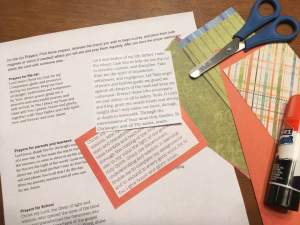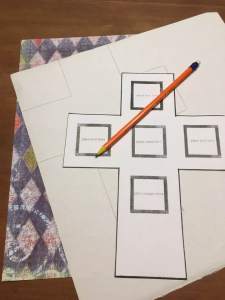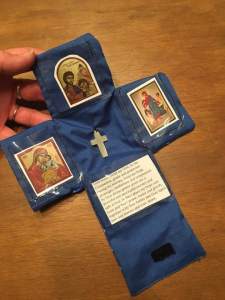Note: This series of blog posts will offer ideas of how to build up the little church in your home. The series will take a closer look at “Blueprints for the Little Church: Creating an Orthodox Home” by Elissa Bjeletich and Caleb Shoemaker. Each week we will take a look at one portion of the book and focus on the wisdom and ideas offered there. Find an overview of the entire book here: https://orthodoxchristianparenting.wordpress.com/2016/06/22/gleanings-from-a-book-blueprints-for-the-little-church-creating-an-orthodox-home-by-elissa-bjeletich-and-caleb-shoemaker/
We thank Elissa Bjeletich, Caleb Shoemaker, and Ancient Faith Publishing for granting us permission to share the book with you in this way. Purchase your own copy here: https://store.ancientfaith.com/blueprints
Week 1: Introduction
Elissa Bjeletich and Caleb Shoemaker begin their collaborative work, “Blueprints for the Little Church: Creating an Orthodox Home” with important introductory pieces. Before they mention anything about building the family’s little church, they quite frankly (and repeatedly) urge their readers to each ask their priest which practices will be the best for their particular family. Each reader’s priest knows them and their family situation and thus can best speak to what will or will not be helpful to building the little church in that particular home.
The introductory chapter offers a bit of background for the book, including reasons the authors wrote it. They found that they needed a book like this when their children were younger, but there was none to be had. So they undertook the task to write this one. This introductory chapter offers suggestions of where to begin the process of creating an Orthodox home. It takes a moment to explain the concept of “the little church”. It also touches on what it means to live an Orthodox life. This first chapter is foundational to the book, and prepares the reader well for the subsequent chapters.
Do you have a parenting question for the “Blueprints For the Little Church” authors? Connect with Elissa here: https://elissabjeletich.com/contact/ and email Caleb at caleb.shoemaker@gmail.com.
Here are a few gleanings that can offer you a closer look at the beginning of the book:
***
“As you attempt to implement the concepts you find here, you may run into trouble. Whenever you’re in doubt, please ask your priest.” (p. 5, “Blueprints for the Little Church: Creating an Orthodox Home” by Elissa Bjeletich and Caleb Shoemaker, Ancient Faith Publishing, 2016)
***
“‘Even at their age they are exposed to all sorts of folly and bad examples from popular entertainments. Our children need remedies for all these things! We are so concerned with our children’s schooling; if only we were equally zealous in bringing them up in the discipline and instruction of the Lord!’” ~St. John Chrysostom (p. 7, “Blueprints for the Little Church: Creating an Orthodox Home” by Elissa Bjeletich and Caleb Shoemaker, Ancient Faith Publishing, 2016)
***
“This book is for parents… We offer this book from sincere hearts to you who desire to present the rich heritage of the Orthodox Church’s teachings for families — what our great saints and elders have often called ‘the little church’.” (p. 9, “Blueprints for the Little Church: Creating an Orthodox Home” by Elissa Bjeletich and Caleb Shoemaker, Ancient Faith Publishing, 2016)
***
“For many families, it is hard enough to get the family up and out of bed for the Divine Liturgy each week — let alone to take on daily prayer, frequent Scripture reading, weekly fasting, Lenten seasons, Vespers, vigils, Matins, and feast days! How can we do everything we’re ‘supposed to do’ when it’s hard enough to find time to do the bare minimum? How are we to raise saints when our toddler doesn’t want to keep his diaper on?” (pp. 10-11, “Blueprints for the Little Church: Creating an Orthodox Home” by Elissa Bjeletich and Caleb Shoemaker, Ancient Faith Publishing, 2016)
***
“‘My wise priest advised me to stop comparing, to know that we are all running this race together but we must run it with our heads down. When I stopped worrying about what others were doing, I was better able to focus and to lead my own family.’ ~ Elissa Bjeletich (p. 12, “Blueprints for the Little Church: Creating an Orthodox Home” by Elissa Bjeletich and Caleb Shoemaker, Ancient Faith Publishing, 2016)
***
“‘One of the hardest things I’ve ever had to do as a parent was ask for help… Don’t be afraid to ask for help. You’ll never know what your family can accomplish when you seek counsel and guidance along the path.’” ~ Caleb Shoemaker (pp. 13-14, “Blueprints for the Little Church: Creating an Orthodox Home” by Elissa Bjeletich and Caleb Shoemaker, Ancient Faith Publishing, 2016)
***
“In our modern culture, we compartmentalize our lives… Yet Jesus clearly calls us to love Him with all our heart, all our soul, and all our mind. There is no compartmentalization in this, but true unity… Christ is calling us to a unified understanding of ourselves and our lives. Love for God must become the foundation of everything, and all aspects of our lives — our jobs and our families and our recreation, our meals and our entertainment — must all be connected to and part of a unified whole…” (p. 15, “Blueprints for the Little Church: Creating an Orthodox Home” by Elissa Bjeletich and Caleb Shoemaker, Ancient Faith Publishing, 2016)
***
“…the reality is that young people are fleeing the faith of their families, but not those whose families have instilled a deep faith within their hearts; and the little church is one of the defining reasons children stay in the Church as they grow up.” (p. 17, “Blueprints for the Little Church: Creating an Orthodox Home” by Elissa Bjeletich and Caleb Shoemaker, Ancient Faith Publishing, 2016)
***
“The Orthodox life is not complicated. It is beautiful in its simplicity, wondrous in its depth, vivifying in its ritual and sacraments. The complications are typically self-imposed when, instead of following the Church’s teachings or the admonitions of our priests and confessors, we try to cobble together a hodge-podge religion based mostly on external trappings and false deadlines.” (p. 19, “Blueprints for the Little Church: Creating an Orthodox Home” by Elissa Bjeletich and Caleb Shoemaker, Ancient Faith Publishing, 2016)
***
If you’re interested in learning more about the ideas found in “Blueprints for the Little Church”, check out this webinar https://www.goarch.org/-/blueprints-for-the-little-church; this keynote address https://www.youtube.com/watch?v=WHPZ57H5zPo; Elissa’s author website https://elissabjeletich.com/; and/or Caleb’s YouTube channel, “May I Have a Word?”: https://www.youtube.com/channel/UCDmih9jUJ5QKGXfU8iKI-aA/videos







 Repeat on a second piece, cut them out, and glue the two together.
Repeat on a second piece, cut them out, and glue the two together.




 Trace the outside of the pattern, adding an extra ½” all the way around for a seam allowance, on the wrong side of two pieces of fabric (or stack both pieces, right or wrong sides together). Cut the fabric.
Trace the outside of the pattern, adding an extra ½” all the way around for a seam allowance, on the wrong side of two pieces of fabric (or stack both pieces, right or wrong sides together). Cut the fabric.




 Here are directions to recycle a mints tin to make a diptych:
Here are directions to recycle a mints tin to make a diptych:








